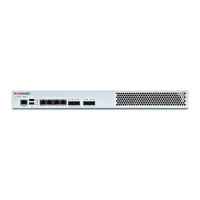Configuring Network Interface (Network Setting) How to set up your FortiWAN
network failure caused by the possible packet looping. In addition, the aggregation of both ports can be used to
increase 1x bandwidth, while also offer HA backup support.
Label : The logical label of the redundant LAN/DMZ or aggregated LAN/DMZ port pair that is grouped by
a selection of two ports. The label is used for later reference in other configurations. The label
can only contain letters of “0-9 a-z A-Z .-_”, and will display in LAN settings as one option.
Mapping : Select two LAN/DMZ ports and group them as redundant LAN/DMZ or aggregated LAN/DMZ
port pair.
As illustrated in the topology below, FortiWAN port1 are mapped to WAN port. Port2 and port3 are configured as the
redundant LAN ports which are connected to Switch1, port4 and port5 as the redundant DMZ ports which are
connected to Switch2. In this case, once one of the two LAN/DMZ links breaks down, FortiWAN will enable the other
LAN/DMZ link to resume the traffic.
Configure [VLAN and Port Mapping] from the Web UI. In this example, Port 1 is set as WAN, Port 2 and Port 3 as HA
LAN port pair and Port 4 and 5 as HA DMZ port pair. Each of the LAN/DMZ pair is connected via a single switch (switch
1 or switch 2). This will remove the chance of single point failure on the switch, and the entire system will be in ‘HA’.
As illustrated in the topology below, two FortiWAN units work in HA mode (See "FortiWAN in HA (High Availability)
Mode"), with one active and the other in standby. Port1 and port2 acts as redundant LAN port for each other, putting
the two units into hot backup mode. This mode offers a significant solution against single point failure in LAN/DMZ.
FortiWAN Handbook
Fortinet Technologies Inc.
34

